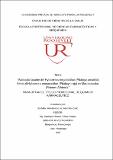Susceptibilidad de la cepa Staphylococcus Aureus frente al efecto antibacteriano del aceite esencial de Thymus Vulgaris l. (tomillo)

Fecha
2022-11-11Autor
Garcia Araujo, Rolando
Paitan Paucar, Luis Armando
Metadatos
Mostrar el registro completo del ítemResumen
El objetivo de evaluar la susceptibilidad de la cepa Staphylococcus aureus frente al efecto antibacteriano del aceite esencial de Thymus Vulgaris L. (Tomillo). Investigación experimental, transversal, con enfoque cuantitativo. El aceite esencial se obtuvo por arrastre de vapor de agua, para la determinación de la susceptibilidad de Staphylococcus Aureus, se utilizó el método de difusión en placa de Kirby-Bauer, con agar Mueller Hinton, se utilizaron concentraciones de aceite esencial al 25, 50 y 100%, teniendo como control positivo la clindamicina y como control negativo agua destilada estéril. Los resultados muestran halos de inhibición de 9.49 mm en la concentración del aceite esencial al 25%, 15.06 mm al 50% y 21.97 mm al 100%, diámetros clasificados en la escala de sensibilidad como sensible, muy sensible y sumamente sensible respectivamente. En conclusión, el Staphylococcus aureus presentó susceptibilidad a todas las concentraciones del aceite esencial de Thymus vulgaris L. (Tomillo), el efecto antibacteriano del aceite esencial al 100% es semejante a la clindamicina. The objective was to evaluate the susceptibility of the Staphylococcus aureus strain against the antibacterial effect of the essential oil of Thymus Vulgaris L. (Thyme). Experimental, cross-sectional research, with quantitative approach. The essential oil was obtained by water vapor entrainment, for the determination of the susceptibility of Staphylococcus Aureus, the Kirby-Bauer plate diffusion method was used, with Mueller Hinton agar, using concentrations of essential oil at 25, 50 and 100%, with clindamycin as a positive control and sterile distilled water as a negative control. The results show inhibition halos of 9.49 mm at the 25% essential oil concentration, 15.06 mm at 50% and 21.97 mm at 100%, diameters classified on the sensitivity scale as sensitive, very sensitive and highly sensitive, respectively. In conclusion, Staphylococcus aureus showed susceptibility to all concentrations of the essential oil of Thymus vulgaris L. (Thyme), the antibacterial effect of the essential oil at 100% is similar to that of clindamycin.
Colecciones
- Estomotología [402]







